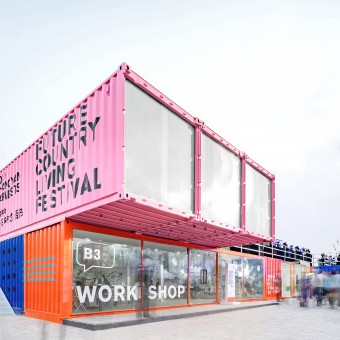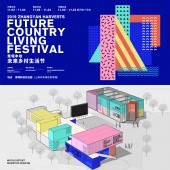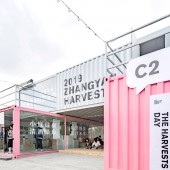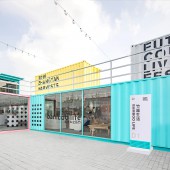DESIGN NAME:
Zhangyan Country Living Festival
PRIMARY FUNCTION:
Exhibition Space
INSPIRATION:
The Memphis school featuring creativity is used to integrate the elements of rural history and culture to form a brand image.
The brand graphics are three-dimensionally extended to form a systematic space design language.
To convey the sustainability sprint, the construction is built by using local abandoned containers and discarded native resources, e.g. wood, straw, and reeds.
We hope to lead the China rural revitalization with the idea of innovation and sustainability and design concept.
UNIQUE PROPERTIES / PROJECT DESCRIPTION:
Urban-rural co-creation innovation experiment initiated by Lou Yongqi, Dean of the D&I, Tongji University, John Sakara, Academician of the RAC, and Aldo Cibic, one of Memphis school founders, to advance practices of sustainable living.
We find the meeting point in various design fields through the exploration of cross-boundary thinking, thereby integrating design concepts to help brands systematically output.
Taking brand culture "innovation" and "sustainable" as the core spirit for the design.
OPERATION / FLOW / INTERACTION:
The original base is in an open suburban meadow, and in order to follow the purpose of environmental protection and sustainable exhibition, a number of old containers are used to form the activity area. By staggering, stacking, interlacing and stretching the containers, the simple rectangular bodies are combined into a variety of dynamic thematic exhibition space.
The left side of the site is distributed by two groups of containers on both sides, forming a more open enclosed form and providing an area for holding forums. On the right side, two groups of containers are rotated and disassembled into the site to create an activity space for holding a marketplace.
PROJECT DURATION AND LOCATION:
The project started in August 2019 in Shanghai and finished in November 2019.
|
PRODUCTION / REALIZATION TECHNOLOGY:
The construction is built by using local abandoned containers and discarded native resources, e.g. wood, straw, and reeds.
SPECIFICATIONS / TECHNICAL PROPERTIES:
The visual system design includes 5000 square meters of activity space.
TAGS:
Innovation,sustainable,Memphis,int
egrating design
RESEARCH ABSTRACT:
Based on the project design background, the design approach decided to follow the following principles: starting from the top design, integrating the independent and compatible relationships among the main visual design, space design and guidance system, and strengthening the systematic output of the brand to the audience. The project hopes to create a blueprint for rural life in the future. The main visual design integrates the design style of Memphis School, and abstracts the "mountain, water, fish, bridge" and other abstract graphics with the regional characteristics of Zhangyan to form the main visual symbol of this event in the form of abstract combination. The Memphis school's design attribute of daring to imagine and break the Convention coincides with the attribute of this event.
The overall visual identity design of the project is based on the Memphis style, starting from the exhibition, speech, workshop and market to carry out spatial narrative, conveying the concepts of "rural", "sustainable", "future" and "innovation".
CHALLENGE:
In order to fit the project proposition of "sustainable development", the space design is creatively combined with the original resources of the site. With the vitality given by design, its sustainability can be re stimulated; with the reuse of materials, a recyclable overall system can be established to reduce waste. The project market constructed with vitality system publicizes the concepts of "everything has an afterlife", "everything makes the best use of" and "each has its own place".
ADDED DATE:
2020-02-25 17:16:05
TEAM MEMBERS (9) :
Jiaqing Wu, Jia Lin, Yin Shi, Lei Yu, Ling Ma, Suying Zheng, Lu Xiao, Xinyan Wang and Ronglan Wang
IMAGE CREDITS:
Tongji Tiandi Neili Lab, 2020.
|










